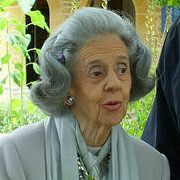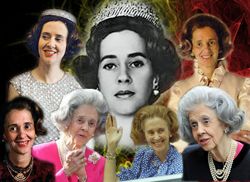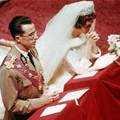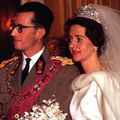LadyLeana

LadyLeana works as a translation manager and lives in the beautiful city of Ghent, Belgium. She has recently decided to combine her love of writing with her equally great love of royalty.
View all articles by LadyLeana In June 2008, Queen Fabiola of Belgium celebrated her 80th birthday surrounded by family and friends. She was the First Lady of Belgium for nearly 33 years, until a sudden heart attack took her beloved husband away. There are opinions galore about the Queen widow. She has been described as both a “Spanish witch” and a conservative Catholic. She was the Mother of all Belgians, as well as their Queen. Her charisma and unparalleled style put Belgium on the international map. She was the first western woman to ever be admitted to the throne room of the Moroccan King Hassan II. During her life as Queen of the Belgians, she was one with the King. But who was she without him? And who is she now? In this article I would like to make a sketch of the life and character of the woman who made le roi triste smile.
In June 2008, Queen Fabiola of Belgium celebrated her 80th birthday surrounded by family and friends. She was the First Lady of Belgium for nearly 33 years, until a sudden heart attack took her beloved husband away. There are opinions galore about the Queen widow. She has been described as both a “Spanish witch” and a conservative Catholic. She was the Mother of all Belgians, as well as their Queen. Her charisma and unparalleled style put Belgium on the international map. She was the first western woman to ever be admitted to the throne room of the Moroccan King Hassan II. During her life as Queen of the Belgians, she was one with the King. But who was she without him? And who is she now? In this article I would like to make a sketch of the life and character of the woman who made le roi triste smile.
Before Baudouin
On Monday, 11 June 1928, a baby girl was born in the palace of the de Mora y Aragon family at the Calle Zurbano in Madrid. She was named Fabiola Fernanda Maria de las Victorias Antonia Adelaida de Mora y Aragon. She was the sixth child and third daughter of Don Gonzalo de Mora Fernández Riera del Olmo and Doña Blanca de Aragon y Carillo de Albornoz Barroeta-Aldamar y Elio. That same day, a kerosene stove exploded in the staff quarters of the palace. One of the servants laconically remarked that one day fireworks will be lighted for this girl… How right she was! Some thirty years later, that same baby would be Queen of the Belgians.
Fabiola de Mora y Aragon was lucky enough to be born into a noble and rich family. Her father’s family had amassed their wealth through mine concessions, and had gained a title through the marriage of her great-grandfather to the sister of a Marquis. Her mother, on the other hand, belonged to an ancient noble bloodline, which can be traced back to the Kings of Aragon among others. The de Mora y Aragons moved in the higher social circles, and were friends with the Spanish King Alfonso XIII. Queen Victoria Eugenia - Queen Ena, as she is more commonly known - became godmother to the little Fabiola.
Fabiola had three brothers, Gonzalo (or Gonzalito), Alejandro, and Jaime (or Jimmy, as he was also called), and three sisters, Neva, Ana-Maria, and Maria del Luz, also called Maria Luz, who was Fabiola’s junior, and also the sister she liked best and was closest to. Several sources say that Fabiola and Maria Luz called each other “my twin.”
During the first years of Fabiola’s life, her beloved Spain was in turmoil. Only three years after she was born, the Spanish people voted against the monarchy in a referendum. The King left Spain in exile and settled in Paris. The de Mora y Aragon family moved to Biarritz, France, close to the Spanish border, to escape the turmoil in their country, hoping that they would be able to return soon. Being pious Catholics, they feared the consequences of a left-wing government. They travelled back and forth to Paris to socialize with the exiled King, who organized his household there. When General Franco finally restored peace in 1933, Don Gonzalo decided to move back to Madrid, but only three years later unrest broke out again, and the Spanish civil war really began.
Don Gonzalo was in Paris with his wife and two of his children when this happened. Fabiola and the other children were at the summer residence in Zarauz, close to San Sebastian. Their German governess, Josephine, decided to try to get the children out of the country, but the eldest son, Gonzalito, refused to come along: he wanted to stay and fight. Josephine first tried to escape to France with the other children by train. Unfortunately, the trains were so loaded with refugees that the axles broke. Then she tried to get the children on a British boat, for which they had to pretend to be British citizens. The children all spoke English fluently, and they would have gotten away with the deception if a secretary from the British consulate had not recognized them. They had to disembark. Some days later, Josephine tried the same tactic, this time with a German boat. The children also spoke German fluently, thanks to Josephine and their butler, who was Austrian. This time, luckily, the five of them got away from Spain and they arrived safely in Biarritz, to be reunited with their parents. So the young Fabiola was a boat refugee at the age of eight.
The family stayed in Biarritz for a few days, but they decided to await the end of the war in Paris, where the family owned an apartment. Doña Blanca, though a devout Catholic, thoroughly enjoyed the life in the city of lights. She was an elegant lady who liked to attend the theatre and the opera. Unfortunately, the Spanish civil war filtered through to the French capital. There were protest rallies all over Paris, and anyone who appeared to be a Spanish noble was in danger of suffering verbal and physical abuse. Don Gonzalo decided to move to Lausanne, in neutral Switzerland, until the end of the war. The family resided in the Hotel Royal for three years. Fabiola and Maria Luz went to school in Lausanne and learned to speak French.
In 1939, the Spanish civil war ended. Aided by Hitler and Mussolini, General Franco had won. The de Mora y Aragon family returned to Madrid to find their home in ruins. It had been used by the communist fighter Dolores Ibarruri Gomez, who had made it the headquarters of the revolutionary women. The fact that their eldest son Gonzalito had survived the war lessened the bitterness of their arrival, and the family soon was restored to their place in the highest social circles.
Life for Doña Fabiola continued as normal for a girl in that social class. Soon the time came when she was introduced into society. For her first ball, at 18, she wore a dress designed by friend of the family, Christóbal Balenciaga, who would also design her wedding dress some ten years later. However beautiful and festive she looked, young Fabiola wasn’t much of a party girl: she returned home by midnight from her first ball. After a while, she went to parties only when chaperoning a friend.
Like most girls of her age and class, Fabiola filled her days with voluntary work, which satisfied her to no end. Every night she came home, tired but content. As all her brothers and sisters married and left the house, Fabiola remained with her parents, almost to the chagrin of her mother, who was convinced that she would never marry. Fabiola herself didn’t seem to share her mother’s concern, reputedly saying to her sister Maria Luz that she would never marry any man unless she truly loved him. She continued to indulge her love of children and perform her voluntary work for the homeless and the poor in Madrid.
In November 1957, tragedy struck the family unexpectedly. Don Gonzalo died after a nasty fall in a badly lit church. The death of the Marquis left his family inconsolable. But even in those difficult times, Fabiola showed her strength and care for others. Christmas followed less than a month after her father's death. Traditionally, Fabiola organized a Christmas party for the servants. Everyone was still too shocked by the death of their master to care about Christmas, and so they were astonished when, on Christmas Eve, Fabiola burst into their quarters carrying presents for all of them. The death of her father made such an impression on the young woman that she decided to become a nurse. Together with some friends, she started training as a private nurse in the military hospital of Gómez Ulla. When she finished her education, she was already 29. She continued to work in the military hospital afterwards, assisting surgeons and attending to officers in the sickbay.
In 1958, Fabiola decided to buy her own apartment, not far from her parental home. Even though she had her own rooms in the palace at the Calle Zurbano, she felt she needed her own place. Her days always followed the same routine. In the morning, she attended church, a habit she still continues. After church she visited her mother, and they had breakfast together. During the day she worked in the military hospital, and in the evening she returned to her mother's home for dinner.
Fabiola was and is emancipated insofar that as she is proud of her independence. She lived in her own apartment at a time when unmarried daughters usually stayed at home. She knew how to drive and had her own car, a Seat 600, even though the family had a driver. She was never a feminist like the Belgian Queen Elisabeth, but she certainly made a stand for women’s rights for independence throughout her life.
Several stories circulate which say that she was engaged to a Spanish nobleman, but the reason for breaking off the engagement is not known. Some say it was because a gynaecological exam had revealed that she would be infertile, but according to several sources Fabiola herself said that she had broken off the engagement because the man was a diplomat and she would have had to move abroad. Another story that circulates, ironically enough both about Fabiola and her husband Baudouin, is that both at one point would have considered taking the veil/habit. There is no evidence where Fabiola is concerned. On the contrary, the fact that she followed a “marriage course” – to which she graduated summa cum laude - would indicate that she believed she would marry one day, and she was determined to do all in her power to make her marriage work. Her never-ending love of children also indicates that she would be happier as a mother than a Mother Superior.
Engagement and Marriage
On Friday 16 September 1960 the world - at least Belgium - came to a standstill. People all over the country froze in their activities while the Brabançonne resounded and Prime Minister Gaston Eyskens announced the engagement of their beloved King to an unknown Spanish lady, Doña Fabiola de Mora y Aragon. For once, politicians were lost for words. Court dignitaries were thunderstruck. The palace spokesman had only one day to organize the most important press conference of his life. Nobody knew who she was, what she looked like, and where, exactly, she came from.
When she was presented to the press in the gardens of Ciergnon Castle, the journalists could not find the words to describe their future Queen. Though not an undisputed beauty, Fabiola enchanted the press with her charisma, her easy smiles, and her openness. And, as if it wasn’t clear before, the King smiled, really smiled. He was so happy that he could finally present his future wife to his people that he even managed to crack a joke. Only a few days before, the papers had published an article in which they speculated about the King taking the habit, something he undoubtedly knew and had a good laugh about, since he remarked to one of the journalists that he had been undecided for a long time: “Trappist or marriage… It seems that I have chosen.”
 Yes, the King had chosen. But how had they met? Fabiola and Baudouin themselves just smiled at each other and said “That’s a story we will tell our children,” when someone asked this question. So the press started digging and came up with several plausible and less plausible stories.
Yes, the King had chosen. But how had they met? Fabiola and Baudouin themselves just smiled at each other and said “That’s a story we will tell our children,” when someone asked this question. So the press started digging and came up with several plausible and less plausible stories.
In one version, Fabiola and Baudouin met at a party in 1955, given by mutual friends. The King presented himself as a Belgian noble, and Fabiola had not recognized him because he had put his eyeglasses in his pocket. They instantly felt a mutual attraction and kept in touch. Of course this would mean that the King had been able to keep Fabiola a secret for almost five years, which, even in those days, would have been unlikely. King Baudouin was, after all, one of the most eligible bachelors in Europe, if not the world.
Another version plays with the idea of a royal matchmaker. Queen Ena, Fabiola’s godmother, supposedly had invited the Belgian King to visit her in Switzerland in 1957, where she was planning for him to meet one of her granddaughters, hoping that the King would fall for her charms. To make the meeting look less suspicious, she invited her goddaughter along as well. Unfortunately, the King was much more impressed by Fabiola, and Fabiola herself fell deeply in love with him. Séguy and Michelland (1995) describe in detail the torments Fabiola presumably went through: how she consulted with her priest, how he told her to go and visit the Brussels Expo of 1958, and ask for an audience with the King while she was there. But Fabiola, even though she visited the Expo, did not have the courage to ask for an audience, and returned home without seeing him. How tantalizing that must have been: so close and yet so far… Luckily for her, she still had her (fairy) godmother, who, with the help of (then) Hereditary Grand Duchess Josephine-Charlotte, Baudouin’s sister, arranged for a new meeting between the two of them. This time, they agreed to keep seeing each other, which resulted in secret meetings all over Europe.
A third and, since 1995, most commonly believed theory about their meeting is the story of Cardinal Suenens, who was one of the King’s closest confidants. In his book, Suenens talks about his role as a clerical matchmaker. Baudouin, according, to the cardinal, had informed him that he was really desperate to get married, and asked for his help. The cardinal introduced the King to Sister Veronica O’Brien in March 1960, who, on their first meeting, addressed him as Mister King. After a long conversation and after receiving a nocturnal vision of the Virgin Mary, Sister Veronica left for Madrid, where she met the papal nuncio Monsignor Antoniutti. He, in his turn, sent the Sister to the principal of a girls' school, who then referred her to Fabiola de Mora y Aragon. On their first meeting, Sister Veronica saw a picture in Fabiola’s apartment, of which she had dreamt the night before. The devout Sister saw this as an omen, and tried to persuade the young noblewoman to accept the King’s hand. But Fabiola kindly explained that she had her roots in Spain, and was not interested in a marriage with the Belgian King. Sister Veronica didn’t give in. In a letter to the King, she described Fabiola as “good looking and striking.” And even though Fabiola refused the offer at first, she agreed to meet the King after an intervention by the papal nuncio. They met in Sister Veronica’s apartment in Brussels, and here the cardinal suddenly becomes very discreet when describing the blind date he had helped arrange: “It is inappropriate to describe how roses burst and bloom.”
According to this story, the couple met a second time in Lourdes, France, at the beginning of July 1960. They both stayed in the same hotel, but in separate rooms. They spent their time talking, praying, and walking along the streets of the little town. Three days after their arrival, they were driving to Tarbes, when Fabiola suddenly asked Baudouin to park the car along the side of the road. They prayed together, three Hail Mary’s, after which Fabiola turned to the King and said “Now it’s yes, and I will not look back anymore.” An acceptance without proposal.
Of the above three stories, the last one is the most widely accepted. The cardinal’s book is filled with quotes from his private correspondence with the King and from the King’s diaries, which Baudouin had left to the cardinal in his will. There are other elements which support his story. The couple's yacht, for example, was named Avila, which, according to Suenens’ notes was Fabiola's codename. Baudouin himself even hinted in that direction. But Baudouin’s diaries only support the story of the acceptance in Lourdes, not of their first meeting. And Fabiola herself was not amused by Suenens’ book. She has, more than once, stated, “I have my story too,” which indicates that Suenens has taken some liberty in describing his role in the matchmaking. She also said, at one point, that she had refused Baudouin’s proposal several times “the first year,” which is also at odds with Suenens’ story, according to which they had not known each other for a year when they got married. We will probably never really know, since the Queen doesn’t give any interviews. But it is obvious that even Suenens’ scenario is not the entire story.
Recently, some people have claimed that the marriage of Baudouin and Fabiola was a marriage of convenience, and that, in the beginning they didn’t love each other at all. The story goes that Baudouin just thought that it was his duty as a monarch to produce an heir, for which he needed a wife, and Fabiola wanted to become a mother. As time went by, they found each other in their faith and really started to love each other. Whether this is true or not, only Fabiola can say. But if it had been true, they certainly gave a very good imitation of a couple in love when they married.
As to how and when the couple informed their family, stories diverge. Leopold and Lilian heard it on the radio, as did Fabiola’s rebel brother Jaime. It is not very clear when Fabiola told her mother, but how she informed her siblings is a well-known story. The family were together in their summer residence in Zarauz, and Fabiola insisted on some pictures being taken. She posed with her sisters, and then smilingly said, “Well, that was my last picture without my fiancé.” Her words only met with disbelief, especially when she said she was engaged to marry the King of the Belgians. Her siblings only believed her when her mother confirmed Fabiola’s story.

 Baudouin and Fabiola married on 15 December 1960. It was a cold and misty winter morning, but that didn’t stop the people from coming out onto the streets to greet their new Queen. The wedding ceremony took over four hours. The civil wedding was performed in the Throne Room at the Royal Palace in Brussels, and the church wedding was celebrated in the St Michel & St Gudule Cathedral, also in Brussels. Dignitaries and Heads of State from all over the world attended both the civil and the church wedding. A remarkable absentee was Queen Elizabeth II, who was still dismayed with the King’s refusal to attend the funeral of George VI. Queen Fabiola was a vision of beauty and elegance on her wedding day, and the King had never looked happier. After the Mayor of Brussels had joined the couple in matrimony, and the papers were signed, Doña Fabiola became the fifth Queen of Belgium.
Baudouin and Fabiola married on 15 December 1960. It was a cold and misty winter morning, but that didn’t stop the people from coming out onto the streets to greet their new Queen. The wedding ceremony took over four hours. The civil wedding was performed in the Throne Room at the Royal Palace in Brussels, and the church wedding was celebrated in the St Michel & St Gudule Cathedral, also in Brussels. Dignitaries and Heads of State from all over the world attended both the civil and the church wedding. A remarkable absentee was Queen Elizabeth II, who was still dismayed with the King’s refusal to attend the funeral of George VI. Queen Fabiola was a vision of beauty and elegance on her wedding day, and the King had never looked happier. After the Mayor of Brussels had joined the couple in matrimony, and the papers were signed, Doña Fabiola became the fifth Queen of Belgium.
